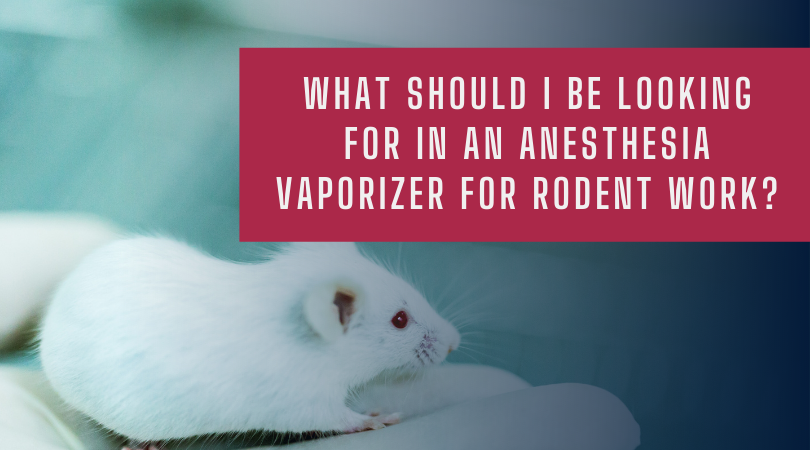What Should I Be Looking for in an Anesthesia Vaporizer for Rodent Work?
Posted on
Anesthesia vaporizers are used for administering volatile anesthetics. They must deliver a reliable and safe concentration of the agent to the receiver in a controllable manner. This article discusses the key elements that are important when selecting a vaporizer to use with rodent subjects.
What do Anesthesia Vaporizers Do?

Anesthetic machines distribute gases that induce sleep, immobilization, and stop pain to rodents during surgical procedures or other experiments. Anesthetic delivery generally consists of an oxygen source, an O2 flowmeter, a pressure regulator, a scavenging device, and a patient breathing circuit.
Anesthetic vapors change the anesthetic liquid into a gas form, providing an exact amount of anesthetic vapor to the subject. As the oxygen flows through the vaporizer during delivery, it picks up the anesthesia vapors. The mix of anesthetic and oxygen then flows through the breathing circuit into the subject’s lungs. The flowmeter minimizes pressure further leading to a precise adjustment of gas flow.
Making the Right Selection
When determining the correct anesthetics, it's important to ensure that the process meets humane and clinical obligations. Selecting an appropriate anesthesia vaporizer is dependent on a range of factors such as species, age, degree of pain, impact on organ systems, and length of the procedure.
Anesthesia vaporizers and monitoring equipment enhance the overall safety of the subject. The vaporizer must be properly calibrated, and anesthetic gases must be scavenged properly. They should also have a direct exhaust and an activated charcoal canister. The canister must be weighed before each use and disposed of when the maximum weight is reached. The weight and calibration records need to be maintained for each vaporizer and should be kept in a safe place.
High-Flow Anesthesia Vaporizers
High-flow anesthesia vaporizers provide expertly controlled concentrations of inhalant anesthesia to ensure the highest levels of safety for animals and technicians. These vaporizers are easy to use, highly tolerable, and produce positive airway pressure. Some animals require a lower flow rate if they have a reduced tolerance, as the atmospheric pollution of high flow anesthesia vaporizers can be elevated. High-flow vaporizers are typically used for larger animals or for anesthetizing multiple animals simultaneously.
Low-Flow Anesthesia Vaporizers
Low-flow anesthesia vaporizers offer high precision delivery, enhanced safety, and a reduction in costs. These vaporizers are easy to control and anesthetize animals using low levels of gas, whereas high-flow vaporizers often have less precise capabilities. These anesthesia vaporizers can automatically determine the correct amount of anesthetic required, without losing excess amounts into the surroundings.
Want to Know More?
Kent Scientific SomnoFlo® and SomnoSuite® are low-flow anesthesia vaporizers that do not require a gas source as they draw in ambient air. However, they can be connected to a gas canister if preferred. They also do not require annual calibration or certification because there are no service requirements. The SomnoSuite has been designed as an all-inclusive surgical solution that does not require external devices.
Kent Scientific also has high-flow anesthesia vaporizers that can be used for safe and effective inhalant anesthesia delivery. If you would like to speak to an expert about which vaporizer is right for your application, you can get in touch with the team here.